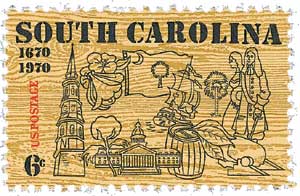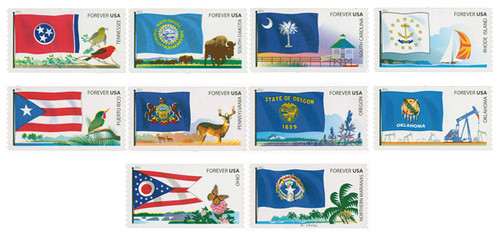
# 4320 - 2011 First-Class Forever Stamp - Flags of Our Nation: S.Carolina
City: Columbus, Ohio
Printed By: Sennett Security Products
South Carolina Admitted To The Union
Before European settlement, more than 30 Indian tribes lived in the area that became South Carolina. The main tribes were the Catawba, Cherokee, and Yamasee. These Indians built semi-permanent log homes, and the majority raised crops.
A Spanish expedition led by Francisco Gordillo explored the Carolina coast in 1521. In 1526, Lucas Vásquez de Ayllón established the first European settlement in what would become the United States. Historians believe the settlement, named San Miguel de Gualdape, was located in the Winyah Bay region of South Carolina. Ayllón brought 500 men, women, and children from Santo Domingo Island to establish the colony.
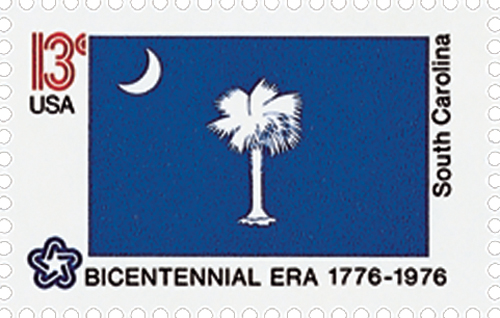
The English claimed ownership of all North America during the early 1600s. However, no attempt was made to settle the South Carolina area until 1663. That year, King Charles II granted a charter to eight English noblemen known as the lords proprietors. The lords proprietors sent settlers to America in 1669. In 1670, at Albemarle Point, they established the first successful, permanent white settlement in South Carolina. The colonists soon moved to Oyster Point in 1680, naming their settlement Charles Town. In 1783, the spelling was changed to Charleston.
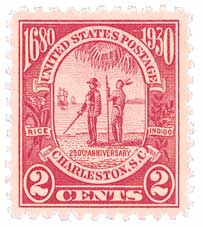
The young colony faced difficult times. The lords proprietors restricted self-government. Yet they offered little assistance and failed to protect the colony. Without aid, the colonists defended themselves against French and Spanish forces, Yamasee Indians, and even pirates. The legendary British pirate Blackbeard terrorized the Carolina coast from 1716 to 1718.
When the lords proprietors rejected attempts to increase the colony’s independence, the settlers rebelled. In 1719, King George I made South Carolina a royal colony. As such, the colonists were granted a great deal of self-government. In 1732, the southern portion of South Carolina became the colony of Georgia.
Many important battles of the War for Independence were fought in South Carolina. Much of the fighting was for control of Charleston. Colonial victories at the battles of Kings Mountain on October 7, 1780, and Cowpens on January 17, 1781, turned the war against the British. In 1781, troops under General Nathaniel Greene and the South Carolina militia drove the British out of South Carolina. The British evacuated Charleston in 1782. In total, 137 battles were fought in South Carolina.
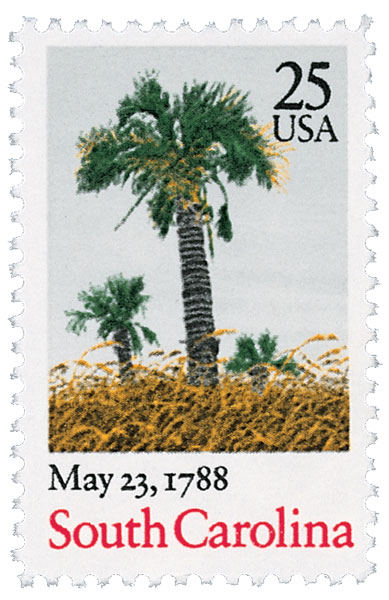
South Carolina ratified the Articles of Confederation on July 9, 1778. On May 23, 1788, it became the eighth state of the Union by ratifying the United States Constitution.
Well before the start of the Civil War, the state came into conflict with the federal government over states’ rights. South Carolina depended heavily on foreign trade. Federal tariffs discouraged foreign trade. In 1828, soon after an economic depression struck the U.S., Congress raised tariffs. This law became known as the “tariff of abominations.” Anti-federal sentiment spread throughout the state. Vice President John C. Calhoun, a South Carolinian, wrote the “South Carolina Exposition,” which claimed that no state could be bound by a law it deemed unconstitutional. When tariffs were raised again in 1832, the state passed the Ordinance of Nullification. This ordinance declared the tariff acts of 1828 and 1832 void. This action prompted President Andrew Jackson to threaten sending troops to enforce federal law. In 1833, Congress passed a compromise tariff bill, and the Ordinance of Nullification was repealed.
When the anti-slavery movement gained momentum in the North, South Carolina was the first state to threaten secession. This threat was made real after the election of President Abraham Lincoln on November 6, 1860. On December 20, 1860, South Carolina became the first state to secede from the Union. Armed conflict started on April 12, 1861, when Confederate troops bombarded Fort Sumter in Charleston Harbor.
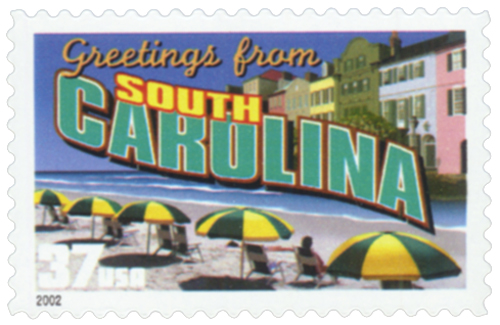
The Civil War devastated the state. A Union blockade smothered the economy. William T. Sherman’s army destroyed plantations and burned the capital city, Columbia. About one fourth of South Carolina’s 63,000 troops were killed during the war.
With the abolition of slavery, agriculture was not as profitable. Additionally, new farms in the West provided greater competition. As a result, South Carolina turned to industrial development. Around 1880, the textile industry began to flourish. An abundance of hydroelectric power and cheap labor caused many northern businesses to move to South Carolina. A number of farmers welcomed the opportunity to work in factories and mills. After the Great Depression, economic conditions quickly improved. During the mid-1900s, federally funded construction projects and the construction of military bases further improved the economy.
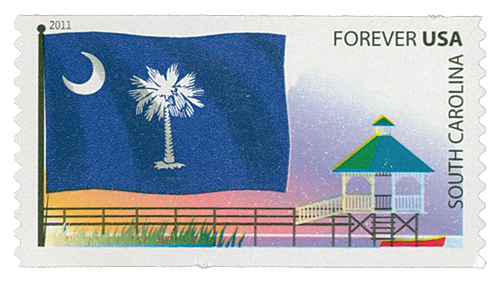
Since the Civil War, African Americans faced many challenges in South Carolina. During the 1800s, the state constitution was rewritten to all but eliminate African American voting. During the late 1940s, African Americans began voting in increasing numbers. Many African-Americans were elected to state and local offices in the 1960s. In 1970, three African Americans were elected to the State House of Representatives – they were the first to serve that body since 1902. South Carolina’s African Americans continue to take a larger role in politics.
City: Columbus, Ohio
Printed By: Sennett Security Products
South Carolina Admitted To The Union
Before European settlement, more than 30 Indian tribes lived in the area that became South Carolina. The main tribes were the Catawba, Cherokee, and Yamasee. These Indians built semi-permanent log homes, and the majority raised crops.
A Spanish expedition led by Francisco Gordillo explored the Carolina coast in 1521. In 1526, Lucas Vásquez de Ayllón established the first European settlement in what would become the United States. Historians believe the settlement, named San Miguel de Gualdape, was located in the Winyah Bay region of South Carolina. Ayllón brought 500 men, women, and children from Santo Domingo Island to establish the colony.

The English claimed ownership of all North America during the early 1600s. However, no attempt was made to settle the South Carolina area until 1663. That year, King Charles II granted a charter to eight English noblemen known as the lords proprietors. The lords proprietors sent settlers to America in 1669. In 1670, at Albemarle Point, they established the first successful, permanent white settlement in South Carolina. The colonists soon moved to Oyster Point in 1680, naming their settlement Charles Town. In 1783, the spelling was changed to Charleston.

The young colony faced difficult times. The lords proprietors restricted self-government. Yet they offered little assistance and failed to protect the colony. Without aid, the colonists defended themselves against French and Spanish forces, Yamasee Indians, and even pirates. The legendary British pirate Blackbeard terrorized the Carolina coast from 1716 to 1718.
When the lords proprietors rejected attempts to increase the colony’s independence, the settlers rebelled. In 1719, King George I made South Carolina a royal colony. As such, the colonists were granted a great deal of self-government. In 1732, the southern portion of South Carolina became the colony of Georgia.
Many important battles of the War for Independence were fought in South Carolina. Much of the fighting was for control of Charleston. Colonial victories at the battles of Kings Mountain on October 7, 1780, and Cowpens on January 17, 1781, turned the war against the British. In 1781, troops under General Nathaniel Greene and the South Carolina militia drove the British out of South Carolina. The British evacuated Charleston in 1782. In total, 137 battles were fought in South Carolina.

South Carolina ratified the Articles of Confederation on July 9, 1778. On May 23, 1788, it became the eighth state of the Union by ratifying the United States Constitution.
Well before the start of the Civil War, the state came into conflict with the federal government over states’ rights. South Carolina depended heavily on foreign trade. Federal tariffs discouraged foreign trade. In 1828, soon after an economic depression struck the U.S., Congress raised tariffs. This law became known as the “tariff of abominations.” Anti-federal sentiment spread throughout the state. Vice President John C. Calhoun, a South Carolinian, wrote the “South Carolina Exposition,” which claimed that no state could be bound by a law it deemed unconstitutional. When tariffs were raised again in 1832, the state passed the Ordinance of Nullification. This ordinance declared the tariff acts of 1828 and 1832 void. This action prompted President Andrew Jackson to threaten sending troops to enforce federal law. In 1833, Congress passed a compromise tariff bill, and the Ordinance of Nullification was repealed.
When the anti-slavery movement gained momentum in the North, South Carolina was the first state to threaten secession. This threat was made real after the election of President Abraham Lincoln on November 6, 1860. On December 20, 1860, South Carolina became the first state to secede from the Union. Armed conflict started on April 12, 1861, when Confederate troops bombarded Fort Sumter in Charleston Harbor.

The Civil War devastated the state. A Union blockade smothered the economy. William T. Sherman’s army destroyed plantations and burned the capital city, Columbia. About one fourth of South Carolina’s 63,000 troops were killed during the war.
With the abolition of slavery, agriculture was not as profitable. Additionally, new farms in the West provided greater competition. As a result, South Carolina turned to industrial development. Around 1880, the textile industry began to flourish. An abundance of hydroelectric power and cheap labor caused many northern businesses to move to South Carolina. A number of farmers welcomed the opportunity to work in factories and mills. After the Great Depression, economic conditions quickly improved. During the mid-1900s, federally funded construction projects and the construction of military bases further improved the economy.

Since the Civil War, African Americans faced many challenges in South Carolina. During the 1800s, the state constitution was rewritten to all but eliminate African American voting. During the late 1940s, African Americans began voting in increasing numbers. Many African-Americans were elected to state and local offices in the 1960s. In 1970, three African Americans were elected to the State House of Representatives – they were the first to serve that body since 1902. South Carolina’s African Americans continue to take a larger role in politics.






